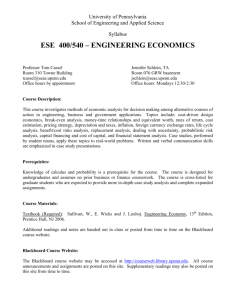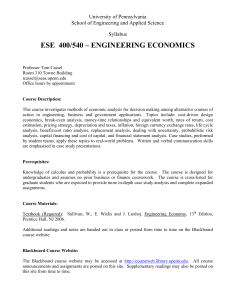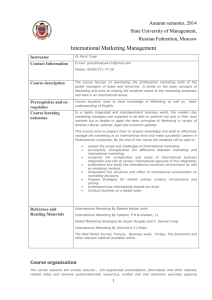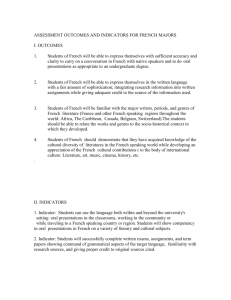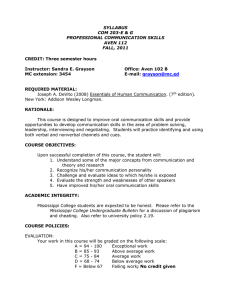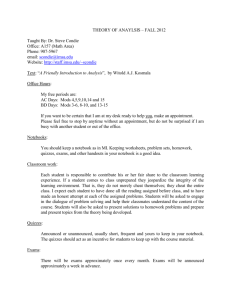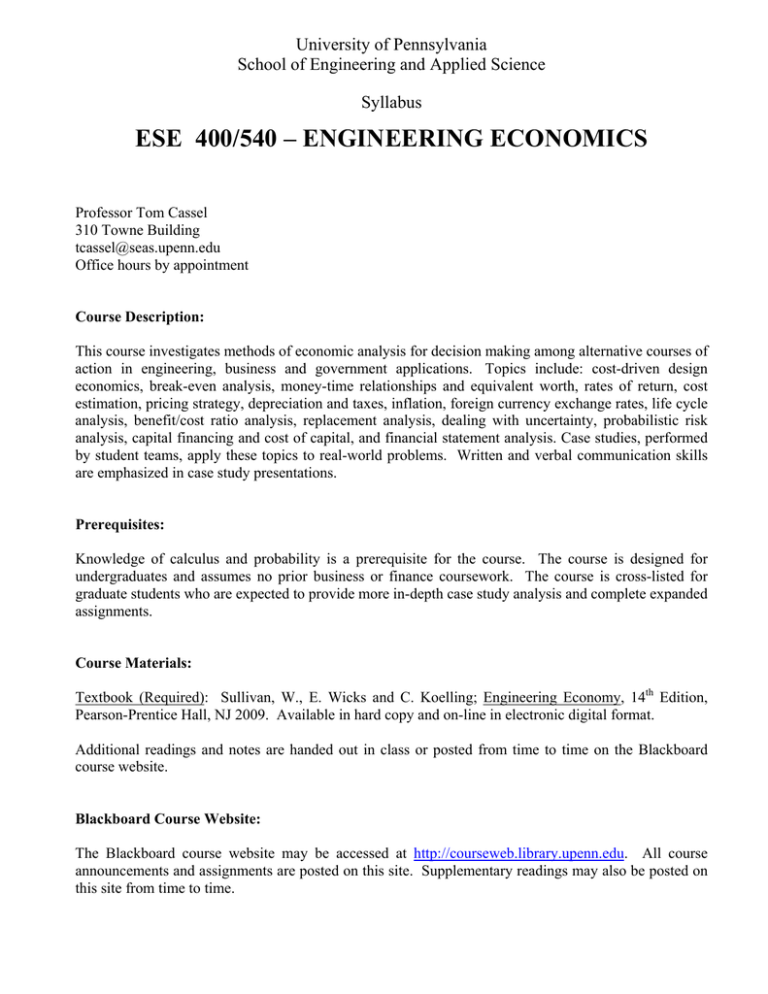
University of Pennsylvania
School of Engineering and Applied Science
Syllabus
ESE 400/540 – ENGINEERING ECONOMICS
Professor Tom Cassel
310 Towne Building
tcassel@seas.upenn.edu
Office hours by appointment
Course Description:
This course investigates methods of economic analysis for decision making among alternative courses of
action in engineering, business and government applications. Topics include: cost-driven design
economics, break-even analysis, money-time relationships and equivalent worth, rates of return, cost
estimation, pricing strategy, depreciation and taxes, inflation, foreign currency exchange rates, life cycle
analysis, benefit/cost ratio analysis, replacement analysis, dealing with uncertainty, probabilistic risk
analysis, capital financing and cost of capital, and financial statement analysis. Case studies, performed
by student teams, apply these topics to real-world problems. Written and verbal communication skills
are emphasized in case study presentations.
Prerequisites:
Knowledge of calculus and probability is a prerequisite for the course. The course is designed for
undergraduates and assumes no prior business or finance coursework. The course is cross-listed for
graduate students who are expected to provide more in-depth case study analysis and complete expanded
assignments.
Course Materials:
Textbook (Required): Sullivan, W., E. Wicks and C. Koelling; Engineering Economy, 14th Edition,
Pearson-Prentice Hall, NJ 2009. Available in hard copy and on-line in electronic digital format.
Additional readings and notes are handed out in class or posted from time to time on the Blackboard
course website.
Blackboard Course Website:
The Blackboard course website may be accessed at http://courseweb.library.upenn.edu. All course
announcements and assignments are posted on this site. Supplementary readings may also be posted on
this site from time to time.
Grading:
Course grades are determined approximately as follows:
Individual homework assignments: 35%
Team case study assignments:
20%
In-class quizzes:
5%
Exams:
40%
100%
Grade adjustments are made for class attendance, participation, and extra credit opportunities during the
course of the semester. Excessive unexcused absences are penalized.
Attendance:
Attendance at all class sessions is presumed. Unexcused absences are penalized in the course grade and
excessive absence can result in failure of the course. As a common courtesy to other students and the
instructor, use of cell phones, laptops and other distracting devices or activities is not permitted in the
classroom.
Assignments:
Written homework assignments must be submitted at the beginning of class on the due date. Late
submittals generally will not be accepted. All work must be shown and must be written neatly and
concisely on 8½ x 11 inch paper. Multiple pages must be stapled together. All individual assignments,
quizzes and exams must be the product of a student’s own effort, consistent with the University’s Code
of Academic Integrity at http://www.vpul.upenn.edu/osl/acadint.html.
Quizzes and Exams:
Unannounced quizzes are given from time to time during the semester. These are brief, open-notes,
closed-book tests, typically covering material from a recent class session.
Two exams are given during the semester: a mid-term exam covering material from the first half of the
course; and an exam near the end of the semester covering material from the second half of the course.
These two exams are given within regularly scheduled class meeting times. An optional final exam is
given during the University’s final exam week. Students may elect to take the optional final exam to
improve their course grade. The score from this optional exam will replace the lower of the above two
exam scores. If the optional exam score is lower than both of the above exam scores, it is discarded.
There will be no make-up exams except as required by University policy.
Re-Grading Policy:
All re-grade requests must be made in writing within one week of the day the assignment, quiz or exam
is returned. The request must be specific and identify the question(s) to be re-graded and the reason for
the re-grade. If a question is submitted for re-grading, the entire assignment or exam may be re-graded
at the instructor’s discretion. Re-grade requests may result in a grade reduction.
Course Outline (Spring Term):
The following course outline is typical for the spring term when the course meets one day per week in a
3-hour session. The outline is subject to change at the instructor’s discretion. Students are advised to
check the Blackboard course website regularly for updated assignments.
Session
Classroom Topic(s)
1
Introduction: Principles and Procedure; Terminology; Price Elasticity; Life Cycle
Cost; Optimal and Break-Even Demand; Cost-Driven Design Optimization; Time
Value of Money; Simple and Compound Interest; Present, Future and Annual
Equivalence; Multiple Interest Formulas.
2
Uniform Gradient Series Cash Flows; Variable, Nominal and Effective Interest
Rates; Compounding More Often than Annually; Continuous Compounding of
Discrete Cash Flows; Introduction to Corporate Finance; Optimal Capital
Structure; Leverage and Weighted Average Cost of Capital; Minimum
Attractive Rate of Return; Present Worth; Bond Value; Capitalized Worth
Method; Future Worth; Annual Worth.
3
HW #1 review; ; Internal Rate of Return (IRR); External Rate of Return (ERR);
Payback Period Capital Asset Pricing Model (CAPM); Financial Statements.
4
HW #2 review; Comparing Alternatives with Equal and Unequal Lives;
Repeatability; Co-Termination; Imputed Market Value; Effective Presentations;
Cost Estimating; Work Breakdown Structure; Estimating Data; Pricing Strategy.
5
HW #3 review; Student case presentations & review; Bond discount
amortization; Index, Unit, and Factor Estimating Techniques; Parametric
Estimating: Power Sizing and Learning Curves; Cost Estimating Relationships;
Value Engineering.
6
HW #4 review; Student case presentations & review; Book & Tax Depreciation;
Placed-in-Service Conventions; Review for Exam #1.
7
Exam #1. HW #5 review; Trade-ins; Depletion; After-Tax Cash Flow Analysis;
Effective and Marginal Tax Rates; Gain (Loss) on Disposal of Asset; Economic
Value Added.
8
Review of Exam #1; Inflation Indices; Foreign Currency Devaluation &
Exchange Rates.
9
HW #6 review; Student case presentations & review; Replacement Analysis;
Dealing with Uncertainty; Break-Even and Sensitivity Analysis; Risk-Adjusted
Returns.
10
HW #7 review; Student case presentations & review; Probabilistic Risk Analysis;
Discrete and Continuous Random Variables; Monte Carlo Simulation.
11
HW #8 review; Student case presentations & review; Cost-Benefit Ratio
Analysis; Operating and Capitalized Leases.
12
HW #9 & #10 review; Student case presentations & review; Review for Exam
#2.
13
Exam #2.
14
Review of Exam #2; HW #11 review; Student case presentations & review.
Assignments Duea
Read S: Ch 1, 2 and 4.1-4.10
HW #1: Ch 2 and 4A problems
Read S: Ch 4.11-4.18 and 5
HW #2: Ch 4B and 5A problems
Read S: Ch 13
HW #3: Ch 5B, 13 and CAPM
problems. Workbook:
“Assessing a Firm’s Future
Financial Health”
Read S: Ch 6
HW #4: Ch 6 problems
Case Study: “Lex Service PLC –
Cost of Capital”
Read S: Ch 3
HW #5: Ch 3 problems
Case Study: “Belgrave Corp.”
Read S: Ch 7
HW #6: Ch 7 and Depletion
problems
Read S: Ch 8
HW #7: Ch 8 problems,
Case Study: “Reto S.A.”
Read S: Ch 9 and 11
HW #8: Ch 9 and 11 problems
Case Study: “Pressco, Inc.”
Read S: Ch 12
HW #9: Ch 12 problems
Case Study: “MSDI-Alcala de
Henares, Spain”
Read S: Ch 10
HW #10: Ch 10 problems
Case Study: “Airbus A3XX:
Building the World’s Largest
Commercial Jet”
HW #11: Capital lease problem
Case Study: “Northeastern
Power Company – NEPCO”
Optional Final Exam
a
Course text (“S”): Sullivan, W.G., E.M. Wicks and C.P. Koelling, Engineering Economy, 14th Ed., Prentice Hall, NJ 2009.
Expected ABET Course Outcomes:
Students completing the course shall:
1. Understand the methodology of cost-driven design optimization [ABET Program Outcome C].
2. Be able to choose among alternative system or project designs based on optimal equivalent
worth (e.g., present, future or annual worth) or return (e.g. internal or external rate of return)
[ABET Program Outcome C].
3. Be able to work effectively in teams of 4 or 5 to perform case study analyses and to present
findings in written reports and verbal presentations [ABET Program Outcome D].
4. Be able to deliver effective verbal presentations including responses to audience questioning
[ABET Program Outcome G].
5. Understand and be able to apply the principles of engineering economics to assess the impacts
of engineering solutions including identifying alternative courses of action, selecting appropriate
units of measure, determining appropriate decision criteria, and quantifying economic outcomes
[ABET Program Outcome H].
6. Understand concepts of foreign currency exchange in projects of international scope [ABET
Program Outcome H].
7. Be able to apply concepts of economic analysis to a real-world, contemporary case study [ABET
Program Outcome J].

